Abstract
New technologies like modular construction are expected to increase the market share in developing countries with a high annual growth rate such as in Egypt. Modular construction solutions that have content depending on the process of off-site construction and on-site transportation gained prominence over recent years due to several benefits, especially their positive impact on the environment. Off-site manufacturing (OSM) and traditional technologies like on-site ones differ in many aspects of design, requirements, logistics, engineering, and others. Many researchers studied modular construction and they fall short of investigating modular construction processes comprehensively and completely. In this paper, the barriers and benefits of using off-site manufacturing (OSM) are collected from the previous studies (that focused on mega projects, high quality, and fast-track projects) to be analyzed using a social network analysis (SNA) to promote the implementation of this new technology mainly in high-annual-growth-rate countries. A survey was used to solicit the opinions of construction practitioners to identify the most significant barriers and obstacles, as well as the benefits of using OSM. Also, due to the capabilities of Building Information Modeling (BIM) to manage shared information and increase the cooperation among project parties, the integration of OSM and BIM is investigated as a promising approach to overcome OSM barriers and enhance its utilization. Analyzing the main barriers’ density and finding out the main solution are involved. Applying this case to a real project in Egypt to study the impact of using (OSM) on-site and exporting the data are also involved. With some results related to the other results and disadvantages that were deduced, the most important advantages and most disadvantages emerged, as well as finding ways to solve them and practical application on the ground.
1. Introduction
Off-site manufacturing (OSM) and modular construction have recently gained huge attention as they can increase quality and safety, shorten project duration, reduce waste, and increase efficiency []. The recent COVID-19 pandemic has resulted in a shortage of healthcare facilities and hospitals in developed countries. Deep et al. [] investigated the key competencies of contractors post-COVID-19 to be highly resilient towards pandemic outbreaks. Their study concluded that the five most critical competencies were managing site safety, leadership skills, technical competence, supply chain disruption, and financial stability. Gbadamosi et al. [] stated that isolation space creation (ISC) and temporary mobile cabins are strategies adopted by governments to face the worst-case scenario and slow down the spread of the virus. They studied and proposed how off-site and modular construction can be used as a solution to face pandemics, respond to emergencies, and treat the shortage of hospitals and healthcare facilities.
According to Smith [], modularization in construction projects requires new decision-making planning and process techniques to reflect the uniqueness and complexity of modular construction requirements. These decision-making techniques include but are not limited to (a) feasibility of modularization concerning project objectives; (b) configuration of modules to ensure optimized construction stages from off-site manufacturing to assembling; (c) development of the project as on-site and off-site work is proportioned; and (d) project planning to minimize lead times and costs. Consequently, Wilson [] stated that modular construction differs significantly from traditional construction. These differences are in the engineering requirements and design, logistics, transportation, and collaboration requirements [,,].
Fast-track projects need new technologies such as OSM that require coordination between all project parties including engineers, fabricators, deliverers, suppliers, and erectors []. As such, the integration of BIM and OSM may result in a remarkable improvement in the construction industry such as cost reduction, quality, and sustainability. According to Li et al. [], the efficiency of OSM increases when employing BIM by adding some advanced tools like 3D laser scanners that are used to make as-built information, create MEP systems, and utilize robotics for faster installation. As such, BIM can secure the information that improves the project scope, supporting processes, and activities throughout the project such as execution, production, maintenance, design, and operation.
Collecting a large number of research, and the research and work on them, are continuing well. There are always security gaps in the subject. This is what was carried out through modern research methods.
Due to the high growth of the population in Egypt and the massive migration to urban areas, Egypt needs a clear plan to face this problem. The Egyptian government is interested in building fourth-generation cities (e.g., New Capital City, Galala City, and Alamein City) to reduce the ravage of urban increase in Egypt. Preventing potential problems and accumulating time and cost in construction are the main areas that should be thoroughly researched when considering new construction methods such as OSM. Accordingly, the management of the construction process, as well as product performance and reliability, are two key areas of discussion in OSM research. Using OSM may not be the right decision in some projects, but it is very effective in other projects.
While searching for research on the topic, it was necessary to look at more than one researcher and more than one country to ensure the collection of ideas from more than one human element thinking about the same matter.
Subsequently, more research is still needed to study the impact of OSM on the construction sector. Henceforth, this paper aims to study OSM using SNA by investigating the influences of the standalone capabilities of OSM on project performance via key productivity indicators. Moreover, the barriers and critical factors for using OSM are identified and analyzed. This paper also aims to provide strategies for BIM to improve OSM projects’ performance.
2. Off-Site Manufacturing (OSM)
Ehwi et al. [] state that OSM is a modern approach that incorporates the production and design of non-volumetric structural components or volumetric units in a factory. These components, such as reinforced concrete walls, floors, columns, bathroom and kitchen fittings, and balconies, are fabricated off-site and later installed in their designated on-site positions within a structure. This method deviates from the traditional practice of building these components directly at the construction site.
The world’s growing population and economic progress are driving up demand for building assets. When it is requested with a conventional deal approach, it results in delays, waste, quality issues, and cost overruns. So, the traditional construction methods result in negative progress and have impacts on economics and the schedule from delivery of the built asset to the required level of supply. On the other side, using off-site manufacturing in the construction industry can speed up the construction process and deliver more quality, in addition to improving safety and sustainability []. In addition, integrating Building Information Modeling (BIM) applications has been used to enhance the off-site construction process. Sharma et al. [] implemented parametric modeling in BIM applications for effective construction optimization. Their work demonstrated that using a rapid wall (glass-fiber-reinforced panels) model, time is saved by 74% and the cost is saved by 7.30% over the conventional design. Although the embodied energy was reduced by 26.2% and the carbon footprint was reduced to 27% through the project, the energy models for this traditional method and the model show that it saves 10% of annual energy. The findings concern the reality reporting of time-parametric variables that are critical for the final composition of rapid wall panels exiting the manufacturing process and being transported to be installed on-site.
Modular construction building and off-site construction are the main strategies to expand capacity rapidly. Off-site manufacturing is a proposed solution through construction to solve operational and post-pandemic phases and face the challenges of pandemic cases through untraditional ways of construction and using off-site manufacturing for emergencies and pandemics. Using an effective solution depends on the main factors that affect the containment of a massive outbreak [,].
In the context of procurement in OSM, Finnie et al. [] studied the effect of early contractor involvement (ECI) on enhancing OSM in New Zealand. The study discussed the importance of integrating design and production in lean construction and identified key factors for effective integration. The study concluded that the main barriers to OSM in New Zealand are industry and market culture, skills and knowledge, logistics and site operations, and regulatory issues. Some of these barriers can be targeted by involving key constructors in the design phase. Deep et al. [] studied the influence of subcontractors in the context of procurement decisions in Australia, results of the study contribute to improving the decision-making processes of both subcontractors and main contractors in strategic procurement.
3. Research Methodology
The methodology used for this research to study the benefits and barriers of using OSM in the Egyptian construction sector includes three main directions: (1) a literature review to collect the factors affecting the use of OSM (that focused on the mega projects, high quality, and fast-track projects), (2) a bibliometric analysis for the collected literature, and (3) a survey to identify the most important factors affecting OSM. A graphical illustration of the survey procedures is provided in Figure 1. In the end, the analysis took place to identify the most important barriers and benefits that need to be solved.
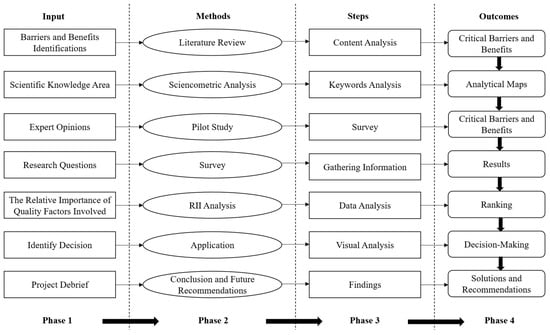
Figure 1.
Flow chart for research methodology.
4. Scientometric Analysis of OSM
In the recent decade, off-site manufacturing has become an important keyword through research engines. This is due to the significant importance and reliance on it in the recent period. Due to the necessity of finding gaps and loopholes and trying to perform complete comprehensive research on the topic, it was necessary to conduct a careful search on keywords in a reliable global search engine. The scientometric analysis is used objectively to know the scientific knowledge area while the review aims to identify the research themes and the corresponding challenges based on scientific metric results. In this analysis, the importance of OSM is presented and linked to research conducted in recent years. At first, a bibliometric review of previous scientific research in this field was employed. The bibliometric research was set by inputting keywords like (OSM, Prefabricated Construction, modular construction, and Precast Construction). The search was made on the scientific search engine SCOPUS with the word OSM and it was studied from 2012 to 2022. All gaps were found between the research due to the necessity of knowing the added value of the research and its importance and working to bridge these gaps.
As shown in Figure 2, scientific research on OSM has been increasing in recent years (except for 2018). This corresponds to the fact that OSM technology has only existed over the past 10 years, and this is due to its need to apply many ready-made services, buildings, and hospitals that are quick to install, such as those used in China to confront the COVID-19 pandemic. As shown, the increase in research on weakness in the post-COVID-19 period documents the importance of applying these ideas and their need in many countries searching for quick and smart solutions.
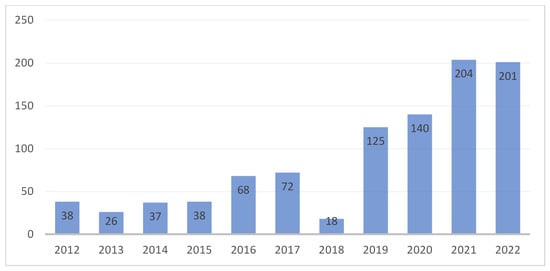
Figure 2.
Yearly publications on OSM from 2012 to 2022.
VOSViewer software (version 1.6.19) [] has been widely used for bibliometric analyses [,]. Sources of these OSM-related journal papers were identified using VOSViewer. It is a software tool for visualizing bibliometric networks and is used to output system-based visualized maps. It creates a network that depends on nodes and edges indicating the closeness level of the specified elements. Figure 3 displays the clusters and inter-relations among these keywords.
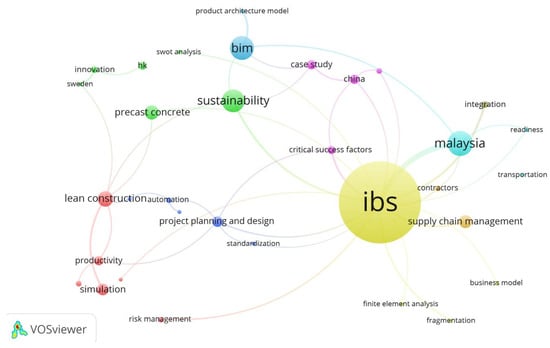
Figure 3.
Co-occurrence of keywords in the research of OSM.
As shown in Figure 3, industrialized building system (IBS) was the highest frequented keyword related to OSM. Nonetheless, more keywords related to sustainability, BIM, supply chain management, and precast concrete were also found. This reflects the increasing research interest in OSM while integrating other fields of study such as BIM and sustainability.
As shown in Figure 4, it is noticeable that countries like the USA, the UK, China, and Malaysia dominated the top of the list, while developing countries like Egypt (or any Arab country) are not on the list. This is due to the lack of this technology and the lack of sufficient research at this level compared to other countries.
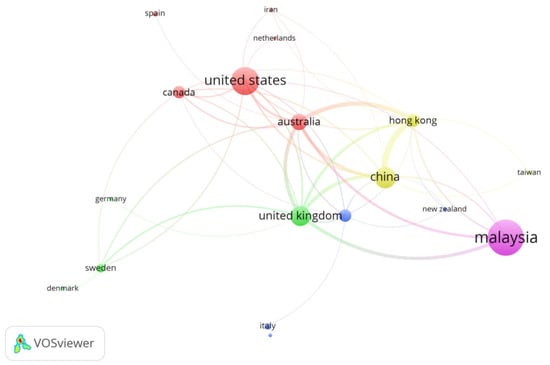
Figure 4.
Co-occurrence of keywords in the research of OSM.
As shown in Figure 5, BIM has a higher weight node than any other keywords related to OSM. A bibliometric analysis retrieved the publications in the field of BIM for OSM and revealed 113 citations. The analysis showed that the BIM-OSM research and the link between them have the prospect of solving data management issues more efficiently. It also shows that this topic still needs more research in the future.
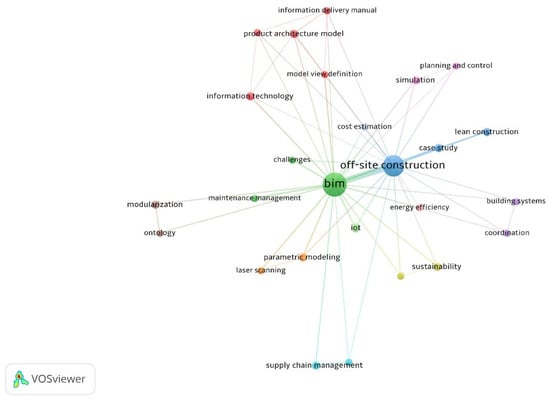
Figure 5.
Author keyword co-occurrence of OSM.
5. Questionnaire Survey
The table below shows the list of barriers and benefits of using OSM at mega, high quality and fast track projects. All of these factors were collected through previous research, as shown below in Table 1.

Table 1.
List of barriers and benefits of using OSM (Mega projects, high quality, and Fast-track projects).
6. Criteria for the Study Sample
To find the most critical factors, the assistance of experts was acquired through a pilot study. At this initial stage, 79 factors between benefits and barriers were collected from previous studies. Before sending those factors in an official questionnaire to know the opinions of experts about the importance of those factors, the opinion of 10 experts was solicited to review the collected factors and obtain their views on the factors. As such, the collected factors were shortlisted to 22 barrier factors and 12 benefit factors as presented in Table 1.
To find the sample size needed in the survey, Equation (1) was used []
where N = population size, e = margin of error (percentage in decimal form), z = z-score, and p = percentage value (as a decimal).
Since the number of engineers = 1 million, the confidence level = 99%, and margin of error = 10. Therefore, the sample size = 168.
7. Data Analysis
The detailed account of the data collection process is illustrated as follows:
- -
- Sample selection: The authors targeted consultants, contractors, and academics operating in Egypt.
- -
- Questionnaire development: As discussed in the previous section, previous studies were the starting point for identifying factors between benefits and barriers. In addition, 10 experts were consulted on these factors before sending the questionnaire on a wider scale.
- -
- Distribution: Online distribution of the survey questionnaire was the only approach adopted.
- -
- Data Analysis: The relative importance index (RII) was used to analyze the output of the survey questionnaire.
Two of the limitations that can be highlighted in the study are the sample representativeness, which means that the sample might not fully represent the industry in Egypt leading to potential biases, and a single geographic location as all the experts who contributed to the questionnaire were operating in Egypt.
Statistics about the participants in the survey were obtained, as shown in Figure 6—the role of each participant, the department, and the number of years of experience in this field. The demographic graphs show the academic background, position, and years of experience of the selected surveyors. Most of the surveyed individuals are civil engineers (46.2%); in addition, site engineers were the most responsive (46.2%). Considering the years of experience, individuals of 15+ years of experience were crucial for the study and represented 33.3% of the responses, while fresh graduates represented 11.1% of the responses.
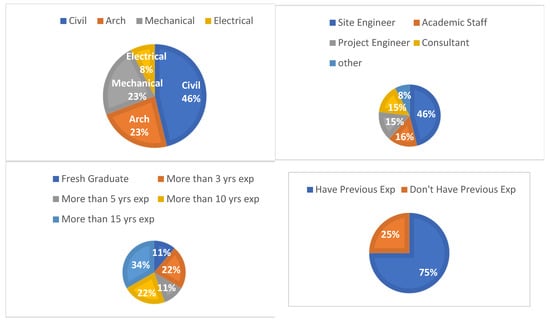
Figure 6.
Questionnaire respondents’ statistics.
The survey focuses on the main benefits and barriers of using OSM. The collected data were analyzed using the relative importance index (RII) to figure out the relative importance of the factors involved. The RII was calculated as per Equation (2) []. The RII of the different factors is presented in Table 2.
where W is the weighting given to each factor by the respondents, A is the highest weight, and N is the total number of respondents. The higher the value of RII, the more important.
RII = Σ W/(N × A)

Table 2.
RII of OSM Barriers and Obstacles.
As shown in Figure 7, “High initial cost”, “Longer lead time”, and “Incertitude of market request” are the main three critical factors that affect applying OSM to the construction sector in Egypt due to many reasons according to experts and engineers. The analysis shows a huge difference between high initial costs and other factors. Also, Figure 8 shows that “Time-saving”, “productivity improvement”, “Asset operation”, “Snagging and defect reduction”, “improvement coordination”, and “Quality improvement” are the main critical benefits of applying OSM in the construction industry in Egypt [].
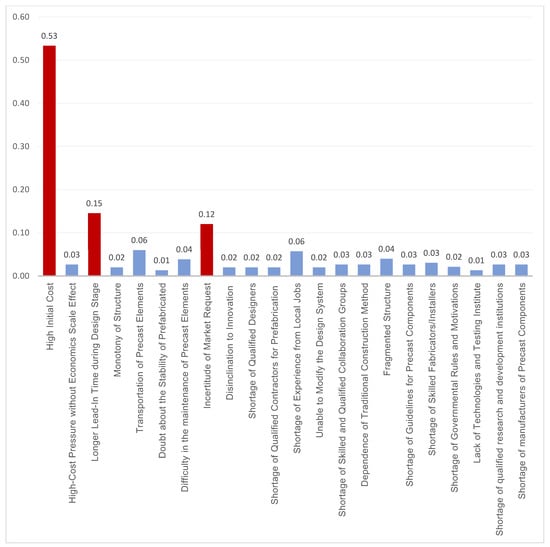
Figure 7.
Relative importance index for barriers and obstacles.
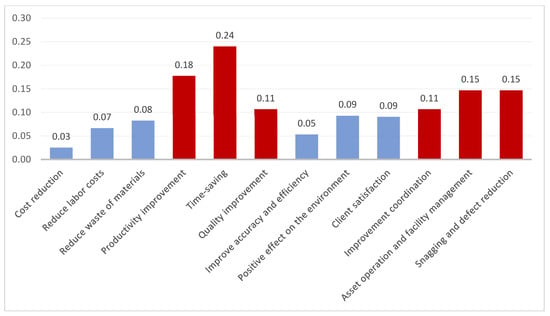
Figure 8.
Relative importance index for benefits.
It is noticeable that there is a large discrepancy between the proportions of the influencing factors, and one can find the most important factor that carries 40% of the total influencing obstacles to getting started. This is due to the lack of off-site industrial technology for companies; even the largest companies do not have sufficient factories to establish this technology. Companies that do not own this industry have to pay large sums of money to factories outside the framework of their industry to implement what is required of them.
There are main benefits of using the distribution factors to indicate the relation. It shows that the benefit factors have close percentages, but the most critical ones are also noticeable. That makes the benefits clearer to persuade the owner and the market to use the OSM in the Egyptian construction sector.
It is noticeable that there is no discrepancy in the ratios between the factors affecting the benefits as opposed to the obstacles, and this is due to the experts’ admiration for the idea and their vision of the importance of all influencing factors and the economic and engineering feasibility of its practical application.
8. Adding BIM to OSM to Improve Benefits and Remove Barriers
Successful OSM operation depends on the exchange of information and technologies between project parties in all project phases from beginning to end. There is integration between OSM and BIM giving a great preference to limiting the problems of the project since the design process began and ending conflicts between the conflicting parties of the project in some cases. It also facilitates the idea of manufacturing due to the ease of naming each element before it is manufactured outside the site and renaming it so that it does not enter the factory with the idea of an untidy fragment structure. BIM is one of the most obvious aspects of rapid, deep, and fundamental change transforming the global construction industry. As reported in recent literature, the main focus of BIM research is to improve the models’ abilities to acquire, store, and share building-related data. These improvements not only increase information management capabilities but also give BIM a role as a facilitator of new technologies and construction methods. OSM, using manufacturing principles, is an effective method for improving the weak performance of the construction industry. Despite the proven benefits, OSM adoption and use in the industry are limited due to some barriers; it has undergone various studies so far. Recent literature highlights that new technology is the facilitator to overcome these barriers of OSM. This research aimed to determine the effect of BIM in facilitating off-site operations. Recent literature shows that it saves improvement design, facilitates collaboration, and covers an accurate and comprehensive amount of information. It appears to be the most useful BIM feature for bridging OSP implementation gaps and avoiding long waiting times, high costs, and adjustment problems. This paper, taking recent literature as a basis, illustrates OSM implementation gaps and then offers suggestions to bridge these gaps through the benefits that BIM brings. To have a broader vision with the input gained from the industry, research can be enhanced using data collection with surveys and face-to-face interviews. It will provide automated data acquisition methods and enhanced web-based collaboration opportunities to collect, store, and share “state” information in BIMs and will access BIMs via the cloud. Future research will focus on the effects of these developments on OSM.
The incorporation of BIM for the design, logistic management, manufacturing, and construction of buildings enhances the construction process by increasing the level of information. [] BIM can be used as a source of information for developers to add more features to the modularization process. According to Eastman and Sacks [], claims, delays, and clashes are the most common issues in projects as a result of fewer communications between project parties and change orders during different project phases while integrated BIM-OSM reduces this issue as the exact details of the construction elements are finalized within early design stages. Also, BIM is capable of resolving most of the clashes arising during construction. For this reason, integrating BIM with off-site manufacturing/modular construction can potentially improve the quality of the existing methods of the construction process [,,].
Ocheoha and Moselhi [] stated that cost and time reduction for construction activities can be achieved with modularization and prefabrication while BIM can improve cooperation and collaboration. Off-site manufacturing is more coordinated compared to traditional construction, which increases the production rate. Ocheoha and Moselhi [] used BIM to generate the quantity takeoff and off-site fabrication schedule with the on-site schedule. Using modularization and prefabrication saves costs by decreasing the activities carried out on-site; also, exchanging data and information more accurately helps to overcome schedule delays, but it may have more initial cost than other methods.
Lui et al. [] used BIM with generative design to extract building component information from the BIM model and classify it into single components and different groups according to materials, function, and sections. The algorithm is developed to formulate structural and logistic constraints and production. A case study was used to validate the framework. An add-on to Autodesk Revit was used to make an automated panelized design to improve the productivity of the project. The system prototype was classified into three models: a BIM parser, a rule-based penalization design algorithm, and a simulation-based performance evaluation model. The researchers found possibilities to develop a framework for off-site manufacturing.
The importance of integrating BIM and OSM to meet the increasing demands of construction and urbanization was emphasized by Kumar and Bhattacharjee []. They aimed to achieve optimal quality, time, and cost by using BIM with OSM. Their work included a data analysis, which was gathered through a survey. They stated that clash detection is the most important factor for BIM-OSM integration. BIM-OSM integration decreases time, saves budget, and reduces project complexity. Thus, BIM can improve managing logistics operations by increasing cooperation between framework parties. Gomez et al. [] studied the integration of BIM, lean construction (LC), and off-site methodologies in the UK construction industry. The investigation reveals that the implementation of LC in off-site construction has increased with the use of just-in-time delivery, visual management, and the last planner system. Such integration led to several benefits: increased quality, time reduction, efficiency, waste reduction, customer satisfaction, higher performance, team integration, and risk reduction. Abanda et al. [] investigated the applicability and benefits of using BIM for OSM. Their research emphasized the positive impact BIM can have on OSM. Nevertheless, Yin et al. [] acknowledged that more research should be performed to support the argument for BIM’s potential benefits for OSM and the interconnections between BIM and OSM.
After incorporating Building Information Modeling (BIM) into OpenStreetMap (OSM) to leverage the benefits of both platforms and calculate the RII (Relative Importance Index) for the same factors, it was observed that the factor of “High initial cost” remained as the only critical factor affecting the method (Figure 9). The other factors had a reduced impact compared to using OSM alone, without BIM.

Figure 9.
RII of barriers after adding BIM (for mega projects, high quality, and fast-track projects).
Prior to integrating BIM as a tool with OSM, four critical factors were identified, which posed challenges in terms of resolution. However, with the inclusion of BIM, three of these factors were successfully addressed, leaving only the issue of high initial cost as a critical factor that required attention [,,,]. As shown in Figure 10, after the integration of BIM and OSM, it is noticeable that some factors lose their weight and heaviness within the survey. This is due to several reasons, namely facilitating BIM and overcoming several obstacles in the way of implementing OSM in general. The integration of two technologies has become a necessity and a duty to reach the goal through the desired means. The use of BIM facilitated the factors that have a significant impact on the ease of work for everyone.
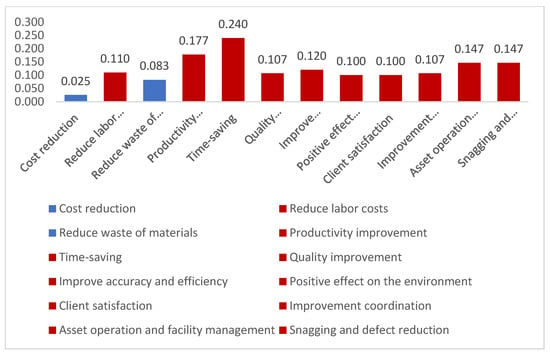
Figure 10.
RII of benefits after adding BIM (for mega projects, high quality, and fast-track projects).
Before adding BIM as a tool to OSM, four critical factors were discovered as illustrated earlier in Figure 7; however, after adding BIM, three of them were removed, leaving only the high initial cost as a critical factor that must be solved.
The most critical benefits come from using modular construction over the old traditional method before adding BIM. It figured out that time saving, increased productivity, asset operation and facility management, snagging and defect reduction, and improved coordination would delay claims and clashes. All of these benefits make modular construction better than traditional methods. Adding BIM to OSM increases the critical benefits with highly improved coordination and client satisfaction.
We considered all factors by analyzing the articles and the survey. It demonstrates that the high initial cost is the most significant impediment to the modular construction method. Second, the longer lead-in time during the design stage is also significant. Thirdly, the incertitude of market requests is one of the most important barriers. Fourthly, the transportation of precast elements can affect the implementation of modular construction tools.
The analysis of the benefits showed that there is more equality between factors than barriers due to the many benefits that can be gained. It was concluded that the benefits are higher than the barriers: saving time, increasing productivity, snagging and defect reduction, asset operation and facility management, and improved coordination. The obtained results in this research showed that the high initial cost represents the main barrier for stakeholders, precluding the implementation of OSM, while a longer lead time was the second main barrier. The market request also represented a huge concern for stakeholders, followed by the transportation of elements. To implement OSM in the Egyptian construction industry, those four factors mainly need to be solved [,,,].
9. Decision-Making Processes or Construction
Multi-criteria decision-making models have been discussed in several previous studies [,,,,,] To support decision-making between OSM and on-site, an application was created to support decision-making by analyzing the data extracted from the RII after the survey and entering them into the application based on the work coordinates in the research paper that depends on the question of influencing and non-influencing factors to approve the start of the project in OSM or on-site construction [,,,].
The application depends on asking the owner before starting the project several questions according to the factors that have been analyzed for importance and on the owner’s decision (Figure 11 and Figure 12). In each factor, data are entered to determine if the project has a sufficient need for its construction through any of the methods listed. It consists of coordination equations that match each other to analyze all of the data together with the RII to give the owner an accurate decision [,,,,,].

Figure 11.
Barrier-factor questions.

Figure 12.
Benefit-factor questions.
Firstly, an owner is asked to find out their ability to overcome the obstacles affecting the start of the project through off-site manufacturing, and then the answers are analyzed through equations based on the analysis of equations according to the results drawn from the questionnaire and the RII. All obstacles are presented to the owner to know their ability to overcome obstacles in the project, such as the high initial cost and others, and they are answered to know the extent of the importance of the project in terms of exiting the OSM method or not, or if it is excited with one of the old methods used before that and accustomed to it.
Secondly, the owner is asked again for the addition that will be provided with the off-site manufacturing, or do they have to implement it inside the site without searching for another technology to add to it? This is due to the importance and type of the project. All of this process is analyzed with a code that was created after analyzing the data extracted from the questionnaire and analyzing their importance. The owner is asked about all the factors that will be added to the project if OSM is used as an alternative to the old methods and does the project need these benefits or does the project have a simple importance that does not require all these benefits.
As shown in Figure 13, after looking at the owner’s answers about the possibility of overcoming the obstacles to implement the system or not, we finally show the appropriate technology for the project, which is followed by research on the application of the project with this possibility or not, and this is due to the ability of the owner to work with it first with their capabilities. With all this interest and money to implement it, unlike some important projects that require removing all obstacles to make the most of the benefits of OSM, we will also find some small and medium enterprises, preferably using OSM, such as Mobilization. This type of prefabricated building is the most famous in Egypt.

Figure 13.
Manufacturing choice.
As shown in Table 3, we will find all the factors in numbers and the extent of their impact on the equation within the program to ensure the accuracy of the program in the process of linking factors with the questionnaire with statistics to produce an application that can determine the decision according to the ground reality and is linked to actual and previous studies. All the factors that normalized weights enable experts and owners to know the extent of their ability to overcome the consequences and the importance of the project to use any method that is most appropriate for them.

Table 3.
Elementary List of OSM Factor Weights.
This application is based on determining the percentages of factors. If the ability of the owner to overcome the challenges and obstacles and the need for all these benefits are exceeded by more than 70%, the project implementation mechanism for OSM is determined. If they are less than that, the project is not started with this technology, and on-site is used instead. As shown in Table 3, to make all the factors reach 100%, they were converted to normalized weights to facilitate the complementarity process between them and make the equation equal to 100% to ensure accuracy.
10. Case Study between OSM and On-Site
As shown in Figure 14, a case study was applied to compare the schedule of a project in the new capital city of Egypt to show the difference between applying the two methods to the same project. As it is clear, there is a huge difference between the use of OSM and off-site in terms of the age and duration of the project, unlike many other comparisons, such as the quality difference between the use of the two methods, which of course will go in favor of OSM. Using OSM in the construction process makes the project finish after only 24 months, while using the old method, which is on-site, makes the project finish after 34 months. It is clear how much time is saved.
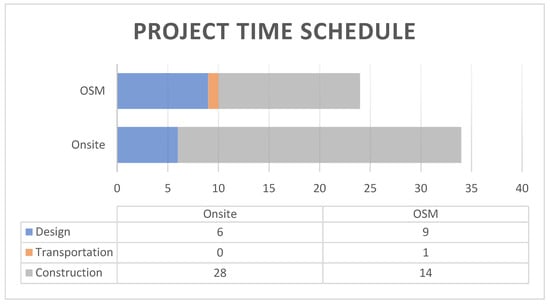
Figure 14.
Project schedule between OSM and on-site.
As shown in Figure 15, the case study is applied to compare the costs of the same project and shows that it needs USD 1.8 billion for off-site while it needs USD 1.4 billion for on-site.
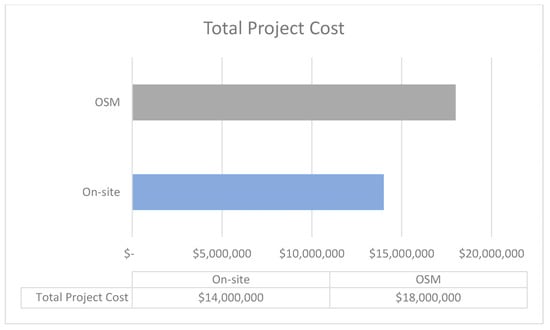
Figure 15.
Total project cost between OSM and on-site.
The case study has proved to show that it is clear, the analysis conducted in the research corresponds to reality, proving the matter of obtaining the study conducted for the project, which shows the schedule difference between the two methods, such as the lack of companies that can use OSM to build these types of buildings and important projects.
11. Conclusions and Future Recommendations
The following points summarize the key findings of the study:
- -
- The analysis showed that the benefits gained are higher than the barriers faced with the OSN. This included saving time, increasing productivity, snagging and defect reduction, asset operation and facility management, and improving coordination.
- -
- The results of the analysis also showed that the high initial cost represents the main barrier for stakeholders precluding the implementation of OSM, while longer lead time was the second main barrier to OSM. The market request also represents a huge concern for stakeholders in addition to the transportation of elements.
- -
- The research attempted to analyze the obstacles and benefits of the BIM-OSM approach and derive future recommendations. All the factors were analyzed, and solutions were proposed highlighting the strengths and gaps related to them.
- -
- The paper offered roadmaps and solutions for the implementation of OSM while integrated into BIM; however, it is worth mentioning that more research should be conducted for the BIM-OSM workflow to be integrated into the industry.
- -
- When analyzing all the benefit factors using SNA, it was found that the percentages of influence between all the benefits were close, which indicates that OSM holds the potential for positively affecting the construction sector.
- -
- Time saving, productivity improvement, asset operation, and facility management, then snagging and defect reduction, were the most influential in that order. It clearly shows that applying the BIM-OSM method will improve construction productivity and quality and reduce time.
- -
- A survey was conducted to identify the obstacles that preclude the widescale adoption of this technology depending on the expertise of surveyed experts in this field. This was led with the analysis carried out on the most important obstacles that were revealed, and solutions were presented.
To address both the high initial cost and longer lead-in time during the design stages, it is recommended to implement robust industrial foundations in construction projects. This approach ensures the availability of technology, making it easier for experts to utilize and enable effective collaboration. Moreover, it creates a large-scale work environment that can accommodate multiple companies, eliminating the need for outdated technologies. By adopting this strategy, the challenges posed with cost and time can be mitigated effectively.
Author Contributions
Conceptualization, E.E. and I.M.; Methodology, M.M.K., E.E., I.M. and M.K.; Formal analysis, E.E. and A.E.; Resources, M.M.K. and E.E.; Data curation, M.M.K.; Writing—original draft, M.M.K.; Supervision, I.M. All authors have read and agreed to the published version of the manuscript.
Funding
This research received no external funding.
Conflicts of Interest
The authors declare no conflict of interest.
References
- Eastman, C.M.; Sacks, R. Relative productivity in the AEC industries in the United States for on-site and off-site activities. J. Constr. Eng. Manag. 2008, 134, 517–526. [Google Scholar] [CrossRef]
- Deep, S.; Joshi, R.; Patil, S. Identifying the Contractor’s core competencies in the post-COVID-19 scenario: Developing a survey instrument. Eng. Constr. Archit. Manag. 2022. [Google Scholar] [CrossRef]
- Gbadamosi, A.Q.; Oyedele, L.; Olawale, O.; Abioye, S. Off-site Construction for Emergencies: A focus on Isolation Space Creation (ISC) measures for the COVID-19 pandemic. Prog. Disaster Sci. 2020, 8, 100130. [Google Scholar] [CrossRef] [PubMed]
- Smith, R.E. Prefab Architecture: A Guide to Modular Design and Construction; John Wiley & Sons: Hoboken, NJ, USA, 2010. [Google Scholar]
- Wilson, J. Design for Modular Construction: An Introduction for Architects; American Institute of Architects: Washington, DC, USA, 2019. [Google Scholar]
- Pan, W.; Dainty, A.; Gibb, A. Establishing and weighting decision criteria for building system selection in housing construction. J. Constr. Eng. Manag. 2012, 138, 1239–1250. [Google Scholar] [CrossRef]
- Rahman, M.M. Barriers to implementing modern methods of construction. J. Manag. Eng. 2014, 30, 69–77. [Google Scholar] [CrossRef]
- Choi, J.O.; Chen, X.B.; Kim, T.W. Opportunities and challenges of modular methods in a dense urban environment. Int. J. Constr. Manag. 2019, 19, 93–105. [Google Scholar] [CrossRef]
- Hardin, B.; McCool, D. BIM and Construction Management: Proven Tools, Methods, and Workflows; John Wiley & Sons: Hoboken, NJ, USA, 2015. [Google Scholar]
- Li, L.; Zhang, Q.; Tian, J.; Wang, H. Characterizing information propagation patterns in emergencies: A case study with Yiliang Earthquake. Int. J. Inf. Manag. 2018, 38, 34–41. [Google Scholar] [CrossRef]
- Ehwi, R.J.; Oti-Sarpong, K.; Shojaei, R.; Burgess, G. Offsite manufacturing research: A systematic review of methodologies used. Constr. Manag. Econ. 2022, 40, 1–24. [Google Scholar] [CrossRef]
- Hu, X.; Chong, H.Y.; Wang, X. Sustainability perceptions of off-site manufacturing stakeholders in Australia. J. Clean. Prod. 2019, 227, 346–354. [Google Scholar] [CrossRef]
- Sharma, S.; Sawhney, A.; Arif, M. Parametric modeling for designing offsite construction. Procedia Eng. 2017, 196, 1114–1121. [Google Scholar] [CrossRef]
- Nguyen, Q.C.; Perera, S.; Ginigaddara, B.; Nguyen, D.T.M.; Rahmawati, R.; Operio, J.H.; Nguyen, D.H.T. An Evaluation of Offsite Construction Recoveries after the Pandemic: The Case of the Southeast Asian Region. Buildings 2022, 13, 50. [Google Scholar] [CrossRef]
- Gündüz, M.; Nielsen, Y.; Özdemir, M. Quantification of delay factors using the relative importance index method for construction projects in Turkey. J. Manag. Eng. 2013, 29, 133–139. [Google Scholar] [CrossRef]
- Finnie, D.; Ali, N.A.; Park, K. Enhancing off-site manufacturing through early contractor involvement (ECI) in New Zealand. Proc. Inst. Civ. Eng.-Manag. Procure. Law 2018, 171, 176–185. [Google Scholar] [CrossRef]
- Deep, S.; Gajendran, T.; Jefferies, M.; Uggina, V.S.; Patil, S. Influence of subcontractors’ “strategic capabilities” on “power”, “dependence” and “collaboration”: An empirical analysis in the context of procurement decisions. Eng. Constr. Archit. Manag. 2022. [Google Scholar] [CrossRef]
- Van Eck, N.; Waltman, L. Software survey: VOSviewer, a computer program for bibliometric mapping. Scientometrics 2010, 84, 523–538. [Google Scholar] [CrossRef] [PubMed]
- Vicedo, P.; Gil-Gomez, H.; Oltra-Badenes, R.; Guerola-Navarro, V. A bibliometric overview of how critical success factors influence enterprise resource planning implementations. J. Intell. Fuzzy Syst. 2020, 38, 5475–5487. [Google Scholar] [CrossRef]
- Moreno, J.L. The Sociometry Reader; Free Press: New York, NY, USA, 1960. [Google Scholar]
- Jaillon, L.C. The Evolution of the Use of Prefabrication Techniques in the Hong Kong Construction Industry. Doctoral Dissertation, Department of Civil and Structural Engineering, The Hong Kong Polytechnic University, Hong Kong, China, 2009. [Google Scholar]
- Lovell, H.; Smith, S.J. Age cement in housing markets: The case of the UK construction industry. Geoforum 2010, 41, 457–468. [Google Scholar] [CrossRef]
- Blismas, N.G.; Pendlebury, M.; Gibb, A.; Pasquire, C. Constraints to the use of off-site production on construction projects. Archit. Eng. Des. Manag. 2005, 1, 153–162. [Google Scholar] [CrossRef]
- Blismas, N.; Wakefield, R. Drivers, constraints and the future of off-site manufacture in Australia. Constr. Innov. 2009, 9, 72–83. [Google Scholar] [CrossRef]
- Khalil, M.; Mahdi, I.M.; Mohamedien, M.; Ibrahim, H.M. Proposed management system of marine works based on BIM approach (technology). J. Eng. Appl. Sci. 2019, 66, 771–790. [Google Scholar]
- Kumar, O.; Bhattacharjee, K. Cost-Benefit Analysis of BIM Implementation into Off-Site Construction. Int. J. Sci. Adv. Res. Technol. 2020, 6, 22–27. [Google Scholar]
- Pow, J.; Gayen, K.; Elliott, L.; Raeside, R. Understanding complex interactions using social network analysis. J. Clin. Nurs. 2012, 21 Pt 20, 2772–2779. [Google Scholar] [CrossRef] [PubMed]
- Krug, D.; Miles, J. Off-Site Construction: Sustainability Characteristics, 1st ed.; Buildoffsite: London, UK, 2013. [Google Scholar]
- Eteifa, S.O.; El-Adaway, I.H. Using social network analysis to model the interaction between root causes of fatalities in the construction industry. J. Manag. Eng. 2018, 34, 04017045. [Google Scholar] [CrossRef]
- El-Aghoury, M.A.; Ebid, A.M.; Mahdi, I.M. Decision support system to select the optimum steel portal frame coverage system. Ain Shams Eng. J. 2021, 12, 73–82. [Google Scholar] [CrossRef]
- Marte Gómez, J.A.; Daniel, E.I.; Yanquing, F.; Oloke, D.; Gyoh, L. Implementation of BIM and lean construction in off-site housing construction: Evidence from the UK. In Proceedings of the 29th Annual Conference of the International Group for Lean Construction (IGLC), Lima, Peru, 12–18 July 2021. [Google Scholar]
- Yin, X.; Liu, H.; Chen, Y.; Al-Hussein, M. Building information modeling for off-site construction: Review and future directions. Autom. Constr. 2019, 101, 72–91. [Google Scholar] [CrossRef]
- Warda, M.A.; Ahmad, S.S.E.; Mahdi, M.I.; Sallam, H.E.D.M. The applicability of TOPSIS-and fuzzy TOPSIS-based Taguchi optimization approaches in obtaining optimal fiber-reinforced concrete mix proportions. Buildings 2022, 12, 796. [Google Scholar] [CrossRef]
- Alazzaz, F.; Whyte, A. Uptake of Off-Site Construction: Benefit and Future Application. World Acad. Sci. Eng. Technol. Int. J. Civ. Environ. Struct. Constr. Archit. Eng. 2014, 8, 1168–1172. [Google Scholar]
- El-Adaway, I.H.; Abotaleb, I.S.; Vechan, E. Social network analysis approach for improved transportation planning. J. Infrastruct. Syst. 2017, 23, 05016004. [Google Scholar] [CrossRef]
- Ramaji, I.J. An Integrated Building Information Modeling (BIM) Framework for Multi-Story Modular Buildings; The Pennsylvania State University: State College, PA, USA, 2016. [Google Scholar]
- Raed, L.; Abd-Elrashed, I.; Mahdi, I.M.; Essawy, A.S. Difficulties of implementing earned value management in construction sector in Egypt. Int. J. Eng. Res. Manag. Stud. 2018, 5, 49–63. [Google Scholar]
- Mahdi, I.M.; Heiza, K.; Elenen, N.A. Value engineering and value analysis of vertical slip form construction system. Int. J. Appl. Or Innov. Eng. Manag. (IJAIEM) 2015, 4, 200–212. [Google Scholar]
- Ocheoha, I.A.; Moselhi, O. A BIM-based supply chain integration for prefabrication and modularization. In Proceedings of the Modular and Off-site Construction (MOC) Summit Proceedings, Hollywood, FL, USA, 22–25 March 2018. [Google Scholar]
- Liu, H.; Zhang, Y.; Lei, Z.; Li, H.X.; Han, S. Design for manufacturing and assembly: A Bim-enabled generative framework for building penalization design. Adv. Civ. Eng. 2021, 2021, 5554551. [Google Scholar] [CrossRef]
- Oltra-Badenes, R.; Gil-Gomez, H.; Guerola-Navarro, V. Methodology for the selection of ERP systems for SMEs. 3c EMPRESA 2018, 7, 10–32. [Google Scholar] [CrossRef] [PubMed]
- Abanda, F.H.; Tah, J.H.M.; Cheung, F.K.T. BIM in off-site manufacturing for buildings. J. Build. Eng. 2017, 14, 89–102. [Google Scholar] [CrossRef]
- Elhegazy, H.; Zhang, J.; Amoudi, O.; Joliviana, N.Z.; Yahia, M.; Eid, M.; Mahdi, I.M. An exploratory study on the impact of the construction industry on climate change. J. Ind. Integr. Manag. 2023, 7, 1–23. [Google Scholar] [CrossRef]
- Lee, C.Y.; Chong, H.Y.; Liao, P.; Wang, X. A critical review of social network analysis applications in complex project management. J. Manag. Eng. 2018, 34, 04017061. [Google Scholar] [CrossRef]
- Thanh, N.V. Designing an MCDM Model for the Selection of an Optimal ERP Software in Organization. Systems 2022, 10, 95. [Google Scholar] [CrossRef]
- Pishdad-Bozorgi, P.; Austin, R.B.; de la Garza, J.M. Network analysis of flash-track practices. J. Manag. Eng. 2017, 33, 04016024. [Google Scholar] [CrossRef]
- Vernikos, V.K. Realizing Off-Site Construction in the Civil Engineering and Infrastructure Sector. Doctoral Dissertation, Loughborough University, Loughborough, UK, 2016. [Google Scholar]
- Wang, X.; Xia, N.; Zhang, Z.; Wu, C.; Liu, B. Human safety risks and their interactions in China’s subways: Stakeholder perspectives. J. Manag. Eng. 2017, 33, 05017004. [Google Scholar] [CrossRef]
- Woldesenbet, A.; Jeong, H.D.; Park, H. Framework for integrating and assessing highway infrastructure data. J. Manag. Eng. 2016, 32, 04015028. [Google Scholar] [CrossRef]
- Zheng, X.; Le, Y.; Chan, A.P.; Hu, Y.; Li, Y. Review of the application of social network analysis (SNA) in construction project management research. Int. J. Proj. Manag. 2016, 34, 1214–1225. [Google Scholar] [CrossRef]
- Mahdi, I.M.; Khalil, A.H.; Mahdi, H.A.; Mansour, D.M. Decision support system for optimal bridge’maintenance. Int. J. Constr. Manag. 2022, 19, 342–356. [Google Scholar]
- Abdul Nabi, M.; El-Adaway, I.H. Modular construction: Determining decision-making factors and future research needs. J. Manag. Eng. 2020, 36, 04020085. [Google Scholar] [CrossRef]
- Assaad, R.; El-Adaway, I.H. Enhancing the knowledge of construction business failure: A social network analysis approach. J. Constr. Eng. Manag. 2020, 146, 04020052. [Google Scholar] [CrossRef]
- Chinowsky, P.S.; Diekmann, J.; O’Brien, J. Project organizations as social networks. J. Constr. Eng. Manag. 2010, 136, 452. [Google Scholar] [CrossRef]
- Abotaleb, I.S.; El-adaway, I.H. Managing construction projects through dynamic modeling: Reviewing the existing body of knowledge and deriving future research directions. J. Manag. Eng. 2018, 34, 04018033. [Google Scholar] [CrossRef]
- Li, Z.; Shen, G.Q.; Xue, X. A critical review of the research on the management of prefabricated construction. Habitat Int. 2014, 43, 240–249. [Google Scholar] [CrossRef]
- Waltman, L.; Van Eck, N.J.; Noyons, E.C. A unified approach to mapping and clustering of bibliometric networks. J. Inform. 2010, 4, 629–635. [Google Scholar] [CrossRef]
- Kamali, M.; Hewage, K. Life cycle performance of modular buildings: A critical review. Renew. Sustain. Energy Rev. 2016, 62, 1171–1183. [Google Scholar] [CrossRef]
- Mostafa, S.; Chileshe, N.; Abdelhamid, T. Lean and agile integration within off-site construction using discrete event simulation: A systematic literature review. Constr. Innov. 2016, 16, 483–525. [Google Scholar] [CrossRef]
- Mahdi, I.; Ors, D.; Ebdi, A.M.; Mahdi, H. Decision support system to select the optimum construction techniques for bridge piers. Ain Shams Eng. J. 2023, 14, 102152. [Google Scholar]
Disclaimer/Publisher’s Note: The statements, opinions and data contained in all publications are solely those of the individual author(s) and contributor(s) and not of MDPI and/or the editor(s). MDPI and/or the editor(s) disclaim responsibility for any injury to people or property resulting from any ideas, methods, instructions or products referred to in the content. |
© 2023 by the authors. Licensee MDPI, Basel, Switzerland. This article is an open access article distributed under the terms and conditions of the Creative Commons Attribution (CC BY) license (https://creativecommons.org/licenses/by/4.0/).